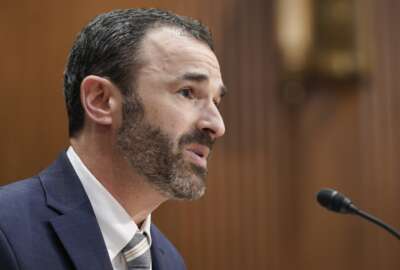Eight years later, GAO finds DHS halfway there
An assessment of the Department of Homeland Security\'s transformation since its founding in 2003 finds major operational accomplishments and lingering management...
wfedstaff | June 4, 2015 10:51 am
By Jared Serbu
Reporter
Federal News Radio
The Homeland Security Department has made big strides since it was created eight years ago, but still has some big management hurdles to overcome, according to an assessment released by the Government Accountability Office to mark the 10-year anniversary of the 9/11 attacks.
GAO has produced more than 1,000 reports on DHS since the department’s founding. All told, auditors have made roughly 1,500 recommendations to Homeland Security, and about half have been implemented, GAO told the Senate Homeland Security and Governmental Affairs Wednesday. While the report found the DHS has made significant accomplishments in its mission areas, it said management of the department still needs work.
Concern from day one
GAO has been concerned about DHS from day one. At the agency’s very inception in 2003, GAO put the department on its high risk list, knowing it would be a serious management challenge to integrate almost two dozen agencies under a brand new umbrella.
“They inherited 22 components, and a lot of them had their own definitions, requirements, systems and methods,” said Comptroller General and GAO director Gene Dodaro in testimony before the committee. “So while it presented an opportunity to start fresh, it also presented a challenge, because you inherited all the problems and concerns.”
Dodaro’s office breaks DHS’s main challenges into three themes: strategically managing its risks, coordinating the various activities of the government’s homeland security functions, and integrating the department’s management functions. GAO said DHS has improved its management and has plans that should improve it even further, but the report expresses concerns about ongoing weaknesses in its procurement and financial management programs.
‘Long, tortured path of procurement’
At Wednesday’s hearing, Sen. Susan Collins (R-Maine), the committee’s ranking member, read a long list of major acquisition programs at DHS that have gone awry, from the Coast Guard’s ship modernization program, to the SBI-Net border security program, to the department’s two failed attempts to build integrated financial management systems.
“What is the department doing to better define requirements up front to ensure real-world testing and evaluation and ensure we don’t have this string of failures continue into the future?,” she asked.
Jane Holl Lute, the department’s deputy secretary, said procurement has been getting a lot of attention lately. She said DHS is working to develop better-defined requirements through joint requirements boards, and the department also is working on a new system of cost estimates.
“That has often bedeviled our procurements at every stage,” she said. “Not only the acquisition of items in particular, but the sustainability costs, which is intrinsic to understanding their lifecycle costs. And we’ve taken a number of steps to strengthen our procurement workforce, including a departmentwide acquisition training program under the head of procurement. Also important in this regard is the intersection of the operators with the procurers. It makes absolutely no sense to go down a long, tortured path of procurement without having an operator’s sensibility introduced every step of the way.”
GAO also said the department’s lack of an integrated financial management system is a liability, and hurts its ability to make informed decisions. The department has made two major efforts to consolidate the financial management systems of its various components, the latest ending this summer with the cancellation of the Transformation and System Consolidation (TASC) contract.
Not a one-size solution
But Rafael Borras, DHS’s undersecretary for management, said the department will stop chasing a one-size-fits-all solution to financial tracking.
“Looking back, we were too ambitious in looking for a single solution,” Borras said in an interview with Federal News Radio. “But we’ve got several components, like [Customs and Border Protection], which actually have good financial systems. So there’s no reason in my mind to build a system that supplants what CBP has in place. My focus is on where we have the greatest need. Financial systems where we’re at the breaking point. Either they’re going to have a system failure, or they just can’t provide the information we need.”
Borras said FEMA will most likely be first on the list as DHS looks to modernize the systems that are the most critically outdated.
On the plus side of the ledger, GAO said DHS has made major accomplishments in its operations, including implementing the secure flight program, deploying Transportation Security Administration screeners to 460 airports, a biometric entry system for visa holders, more resources at ports and borders, and a new emphasis on cybersecurity.
Homeland Security Secretary Janet Napolitano, speaking at a Center for Strategic and International Studies event earlier Wednesday, said the department has sometimes had to learn how to improve its operations through its missteps, such as the failure to intercept the 2009 Christmas Day bomber before he boarded a plane in Amsterdam.
“It turned out there was information CBP had about him on this side of the ocean that TSA didn’t have on that side of the ocean, because the TSA databases and the CBP databases were not linked,” she said. “That is no longer the case. We are now able at airports that are last points of departure to do a lot of pre-screening work before a passenger even gets to the airport.”
RELATED STORIES:
Chertoff: Created after 9/11, DHS has evolved
DHS cancels $450M award to CACI
DHS’ lack of financial clarity a huge liability
(Copyright 2011 by Federal News Radio. All Rights Reserved.)
Copyright © 2025 Federal News Network. All rights reserved. This website is not intended for users located within the European Economic Area.





